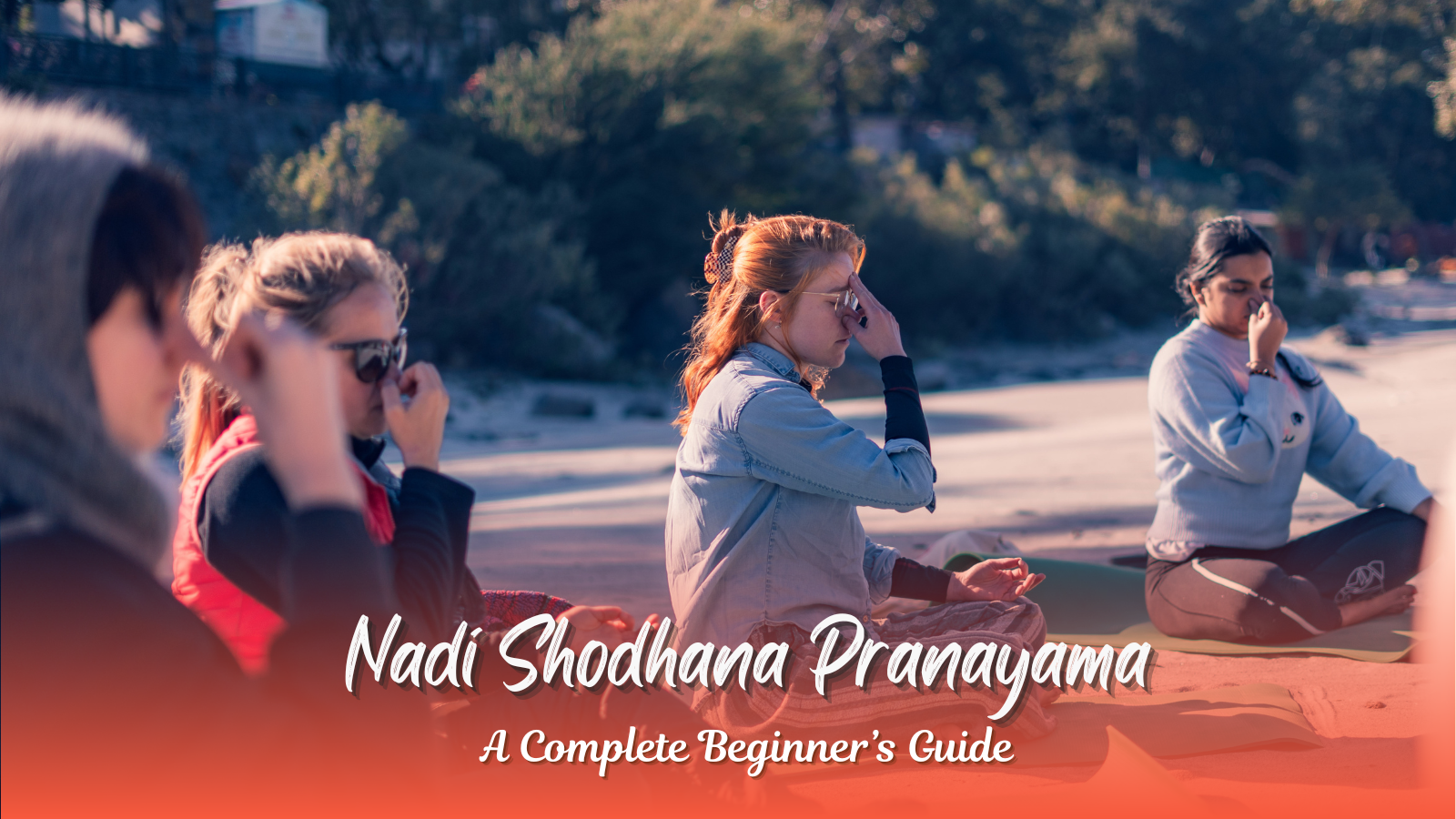What Is Nadi Shodhana Pranayama?
Nadi Shodhana Pranayama is known as “Alternate Nostril Breathing”, a fundamental technique for doing pranayama in yoga. This engages the rhythmic breathing by every nostril alternately and this helps to balance the flow of prana that is “life force energy” within the body. Meaning of Nadi Shodhana Pranayama is a yogic breathing method that includes substituting the breath between the nostrils. The term ‘Nadi’ alludes to the unobtrusive energy directed in the body, ‘Shodhana’ signifies purification, and ‘Pranayama’ means breath control.
Nadi shodhana pranayama benefits physical, mental, and emotional well-being. In this exhaustive guide, we will dive into the essence of Nadi Shodhana Pranayama benefits, investigate its various advantages, and give a step-by-step guide on the most proficient method to play out this simple yet strong technique.
Meaning of Nadi Shodhana Pranayama
- Nadi indicates the pathways or channels in the subtle energy body.
- Shodhana implies cleansing or purification.
- Pranayama maintains regulation and control of breathing
Hence, Nadi Shodhana Pranayama is known as the “purification of the energy channels through breath control”. You can know the meaning of Nadi Shodhana Pranayama by doing better practices through 500 Hour Yoga Teacher Training in Rishikesh.
Purpose of Nadi Shodhana Pranayama
Nadi Shodhana Pranayama’s benefits are as follows:
- Balancing the nervous system: The meaning of nadi shodhana pranayama is directing the progression of prana through the Ida (left) and Pingala (right) nadi, it assists with blending the sympathetic and parasympathetic nervous systems. This can lessen stress, anxiety, and improve on general profound strength.
- Calm the mind: The rhythmic breathing example instigates a state of deep relaxation and serenity, calming the mind’s relentless prattle.
- Develop focus and concentration: Nadi shodhana pranayama steps are helpful to increase mental stability and reduce mental damage, nadi shodhana would effectively enhance concentration and focus.
- Increase sleep quality: By calming the sensory system and reducing stress, it can assist with further developing sleep quality and mitigate a sleeping disorder.
- Develop energy level: While promoting relaxation, it likewise stimulates the body and psyche, leaving you feeling invigorated and revived, and how to do nadi shodhana pranayama gives you proper management of your body.
- Maintain Respiratory health: Regular practice can assist with further developing lung capability, and reduce respiratory issues like asthma and sensitivities.
- Increase overall well-being: By adjusting the energy flow within the body, Nadi Shodhana advances a feeling of overall well-being, physical and mental harmony.
500 Hour Yoga Teacher Training in Rishikesh can teach you how to do nadi shodhana pranayama, and for this, you can contact Gurukul, Yogpeeth Rishikesh. Moreover, if you are exploring Nadi Shodhana Pranayama, you might also find our detailed guide on Pranayama insightful. Besides, it covers the fundamentals of breath control and its profound impact on mind and body.
How to perform Nadi Shodhana Pranayama
Nadi shodhana pranayama’s steps are discussed below in a proper way.
Step 1: Finding a comfortable seat
- Sit serenely in a cross-legged position (Sukhasana) or whatever another stance that is considered a straight spine.
- Delicately shut your eyes and bring your attention to your breath.
Step 2: Arrange your right hand
- Tenderly twist the file and centre fingers of your right hand towards your palm.
- Expand your thumb, ring finger, and little finger.
Step 3: Closing of right nostril
- Gently press your right thumb against the right half of your nose to close the right nostril.
Step 4: Inhale through the left nostril
- Inhale deeply and slowly through the left nostril
Step 5: Closing the left nostril
- Gently press your ring finger against the passed-side of your nose to close the left nostril.
Step 6: Exhale through right nostril
- Exhale completely and slowly through the right nostril
Step 7: Inhale through right nostril
- Inhale slowly and deeply through the right nostril
Step 8: Close the right nostril
- Delicately press your right thumb against the right half of your nose to close the right nostril.
Step 9: Exhale through the left nostril
- Exhale slowly and deeply through left nostril
Step 10: Repeat
- Proceed with this pattern of breathing in and breathing out through every nostril on the other hand for 5-10 minutes or according to your solace level.
A detailed step by step guideline can make you more comfortable about practicing Nadi Shodhana Pranayama through 500 Hour Yoga Teacher Training in Rishikesh.
Tips for Beginners
In understanding the meaning of nadi shodhana pranayama, you have to gain a clear idea regarding yoga and pranayama. Those who are beginners and starting to learn how to do nadi shodhana pranayama can contact us for step by step guidance.
- Start with a few rounds: Start with 3-5 rounds and bit by bit increment the number of rounds as you become more agreeable.
- Focus on the breath: Focus on the impression of the breath as it streams all through your nose to learn how to do nadi shodhana pranayama.
- Maintain a steady rhythm: Attempt to keep a smooth and even musicality all through the training.
- Be patient and gentle: Don’t drive your breath. Practice with tolerance and delicacy.
- Practice regularly: For greatest advantages, practice Nadi Shodhana Pranayama consistently, preferably two times every day, morning and night.
You can get the best instructions from the Yoga School in Rishikesh through 500 Hour Yoga Teacher Training in Rishikesh.
Nadi Shodhana Pranayama benefits
- Diminishes pressure and tension
- Further develops concentration and fixation
- Calms the psyche
- Further develops rest quality
- Supports energy levels
- Upgrades generally speaking prosperity
- Enhances respiratory wellbeing
Nadi Shodhana Pranayama Steps
- Track down an agreeable seat.
- Set up your right hand.
- Close the right nostril.
- Breathe in through the left nostril.
- Close the left nostril.
- Breathe out through the right nostril.
- Breathe in through the right nostril.
- Close the right nostril.
- Breathe out through the left nostril.
- Repeat
When should we avoid Nadi Shodhana?
- During menstruation: Vigorous pranayama practices should be avoided as per our recommendation.
- During illness: If you are encountering any intense disease, it is ideal to talk with a certified yoga educator before rehearsing.
- After heavy meals: After a heavy meal, practicing needs to be avoided immediately.
FAQs
1. What is the difference between Nadi Shodhana and Anulom Vilom?
Nadi Shodhana and Anulom Vilom are frequently utilized reciprocally, and their strategies are basically the same. In any case, a few subtle contrasts exist:
- Focus: The cleansing of the energy channels is pointed up by Nadi Shodhana, while Anulom Vilom centers around adjusting the Ida and Pingala Nadi.
- Rhythm: Anulom Vilom might include a somewhat unique rhythm, with a more drawn-out maintenance of breath (kumbhaka) among inhalations and exhalations.
2. What is Nadi Shodhana Pranayama good for?
- Nadi Shodhana has importance for:
- Reduction of stress and anxiety
- Improvement of focus and concentration
- Calming the mind
- Improvement of sleep quality
- Increasing energy levels
- Development of respiratory health
- Increasing overall well-being
3. Is nadi shuddhi and Nadi Shodhana same?
Yes, nadi shuddhi and Nadi Shodhana are generally the same pranayama technique.
4. When should we avoid Nadi Shodhana?
- During menstruation
- During illness
- After heavy meals
Conclusion
Nadi Shodhana Pranayama is a simple yet significant practice that can effectively affect your general prosperity. By integrating this procedure into your day to day practice, you can participate in a more profound feeling of quiet, clarity, and balance.
Nadi Shodhana Pranayama steps make sure to rehearse with persistence and consistency, and give attention to your body. In the event that you have any worries or underlying medical issues, talk with a certified yoga teacher or medical services proficient prior to starting any new yoga practice.
In the event that you are keen on developing comprehension you might interpret yoga and pranayama, enrolling in a 500-Hour Yoga Teacher Training program in Rishikesh, India can be considered. Rishikesh is prestigious as the “Yoga Capital of the World” and an extensive variety of excellent educator preparation programs are seen in Rishikesh.
In-depth knowledge of yoga philosophy, anatomy, physiology, pranayama, meditation, and teaching methodologies can be gained by completing a 500-Hour Yoga Teacher Training Program in Rishikesh.
This comprehensive guide which has been provided with you gives you valuable insights into Nadi Shodhana Pranayama. In such circumstances, by incorporating this simple yet powerful technique into your daily practice, you can start your journey through Yoga School in Rishikesh blended with inner peace and harmony. Yoga School in Rishikesh helps you in your journey.


